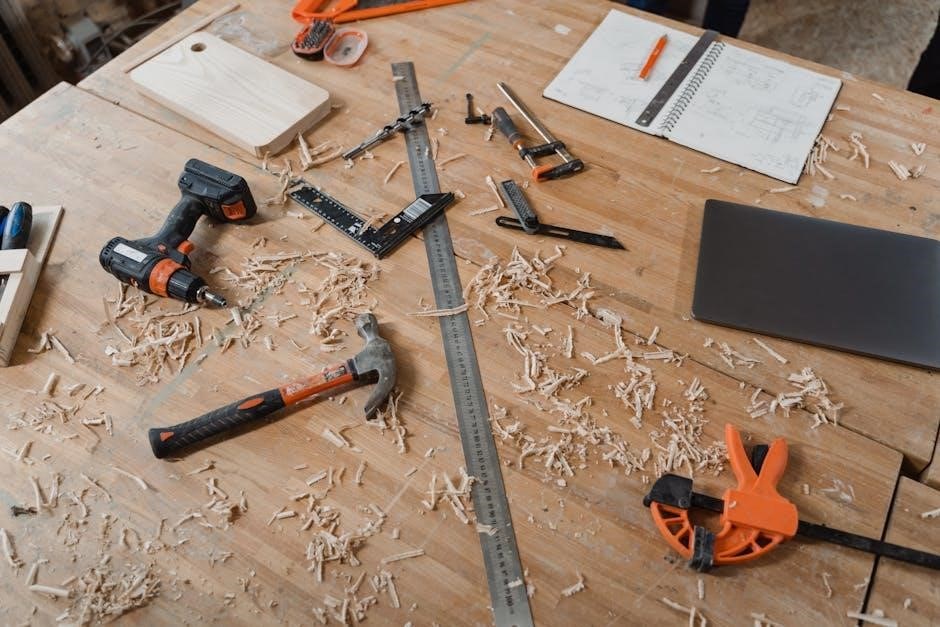drill guides for portable drills
Portable drill guides enhance precision and versatility for handheld drills, offering consistent results without a drill press. They are ideal for achieving straight, angled, or rounded holes effortlessly.
Understanding the Importance of Precision Drilling
Precision drilling is crucial for achieving professional results in woodworking and metalworking projects. Accurate holes ensure proper fitment of components, reduce material waste, and enhance the overall quality of finished work. Portable drill guides play a vital role in maintaining consistency, especially when a drill press is unavailable. They minimize errors, allowing for straight, angled, or rounded holes with ease; This level of control is essential for complex projects and ensures clean, precise outcomes every time.
Overview of Portable Drill Guides and Their Benefits
Portable drill guides are versatile tools designed to enhance the accuracy and consistency of handheld drilling. They offer a cost-effective alternative to drill presses, allowing users to achieve precise, straight, or angled holes. These guides are ideal for professionals and DIYers alike, providing stability and control. Their compact design makes them easy to transport and store, while ergonomic features improve comfort during use. By ensuring accurate results, portable drill guides boost efficiency and reduce errors in various projects.
Types of Drill Guides Available
Portable drill guides come in adjustable and fixed types, offering versatility for various drilling tasks. Specialized guides cater to angled and round stock drilling, ensuring precision and durability.
Adjustable vs. Fixed Drill Guides
Adjustable drill guides offer versatility, allowing users to drill at various angles and depths, making them ideal for complex projects. Fixed guides provide consistent, straight holes but lack flexibility. Adjustable guides, like the Milescraft DrillMate, enable precise angled drilling and are portable, suitable for round stock and edge drilling. While adjustable guides enhance creativity, some users find fixed guides sufficient for basic tasks. Both types ensure accuracy, but adjustable guides are preferred for versatility and multi-angle drilling needs, offering more control over diverse projects.
Specialized Guides for Angled and Round Stock Drilling
Specialized guides for angled and round stock drilling offer advanced features for precise hole placement. They include self-centering V-grooves for round materials and adjustable angle settings, such as 45°, 60°, and 90°, ensuring versatility. These guides accommodate various drill bits, including spade and Forstner bits, and are ideal for projects requiring angled or curved drilling. Their robust designs prevent slipping and ensure clean, accurate holes, making them essential for professionals and DIYers seeking precise results in complex drilling tasks.

Key Features to Consider
Key features of portable drill guides include precise alignment mechanisms, stability enhancements, and ergonomic designs, ensuring accurate and comfortable drilling experiences, even in various work environments.
Alignment Mechanisms for Accuracy
Alignment mechanisms in portable drill guides ensure precise hole placement, featuring self-centering V-grooves for round stock and adjustable stops for consistent depth control. Bushings and bearings provide smooth operation, while ergonomic designs enhance stability. These mechanisms prevent drill bit walking or deflection, delivering accurate results. High-quality materials, like all-metal construction, further improve durability and alignment consistency, making them essential for professional-grade drilling projects. Proper alignment ensures straight, clean holes, even in challenging materials or angles, maximizing efficiency and precision in various tasks.
Stability and Ergonomic Design Enhancements
Portable drill guides feature non-slip rubber feet and enlarged bases for stability, preventing movement during drilling. Ergonomic designs with comfortable grips reduce fatigue, while lightweight materials enhance portability. Some models allow mounting to work surfaces, ensuring rigidity and control. These enhancements provide a secure drilling environment, minimizing vibrations and improving accuracy. The combination of stability and ergonomic features makes these guides user-friendly, suitable for extended use and various applications, from workshops to on-site projects, ensuring consistent and precise results every time.
How to Choose the Right Drill Guide
Selecting the ideal drill guide involves considering your specific needs, such as required angles, drill bit sizes, and material types. Evaluate features like adjustability, stability, and ergonomic design to ensure optimal performance for your projects, enhancing accuracy and efficiency in various drilling tasks.
Factors to Consider: Intended Use and Budget
When selecting a drill guide, consider its intended use, such as straight holes, angled drilling, or round stock. Budget plays a crucial role, with options ranging from basic models to advanced, all-metal constructions. Assess whether adjustable angles or depth stops are necessary for your projects. Understanding these factors ensures you choose a tool that meets your needs without unnecessary expenses, balancing functionality and cost-effectiveness for optimal results in your woodworking or fabrication tasks.
Evaluating Product Reviews and Ratings
Evaluating product reviews and ratings helps identify the best drill guides. Many users praise portable guides for their accuracy and versatility, with high ratings for functionality and ease of use. Reviews highlight features like adjustable angles and sturdy constructions, while some note issues with stability and build quality. Assessing feedback ensures informed decisions, balancing performance and value. Pay attention to common praises, such as precise drilling, and criticisms, like wobble or assembly challenges, to find the right tool for your needs and budget.

Setting Up and Using Your Drill Guide
Setting up your drill guide involves assembling and attaching it securely to your drill and workpiece. Ensure stability by using auxiliary bases or clamps for edge drilling, following manufacturer instructions for optimal performance and precise results.
Step-by-Step Assembly and Attachment
Begin by unboxing and organizing all components, ensuring no parts are missing. Attach the drill guide to your portable drill, aligning the chuck securely. Use the provided alignment features to ensure accuracy. Secure the guide to your workpiece using clamps or auxiliary bases for stability, especially near edges. Follow the manufacturer’s instructions for tightening and calibrating the guide. For added stability, consider mounting the guide to a larger base or work surface. This setup ensures precise drilling and minimizes movement during operation.
Calibration for Optimal Performance
Calibrate your drill guide by ensuring all parts are tightly secured and aligned. Use a test drill bit to check alignment and make adjustments as needed. For precise depth control, set the stop collar according to your project requirements. Regularly inspect and maintain the guide’s moving parts, applying lubrication if necessary. Proper calibration ensures consistent accuracy and prevents wobbling or misalignment during drilling. This step is crucial for achieving professional-grade results with your portable drill guide.
Tips for Effective Drilling
Ensure stability by securing the guide firmly. Use sharp, high-quality bits for clean results. Maintain proper alignment and keep the drill guide clean for optimal performance always.
Best Practices for Maintaining Accuracy
For precise drilling, always secure the guide firmly to prevent movement. Use sharp drill bits to minimize deflection and ensure clean cuts. Regularly clean and lubricate the guide to maintain smooth operation. Calibrate the guide periodically to ensure alignment accuracy. When drilling, apply steady, consistent pressure to avoid wobbling. For angled or rounded stock, use specialized guides to maintain control and achieve professional results consistently.
Troubleshooting Common Issues
Common issues include wobbling drills, misaligned holes, and stuck bits. Check for loose connections and ensure the guide is securely attached. Lubricate moving parts to reduce friction. For wobbling, tighten the drill chuck and ensure the bit is straight. If bits stick, use a key to tighten properly. Adjust alignment mechanisms for accuracy. Regular maintenance and proper setup can prevent most problems, ensuring precise and efficient drilling every time; Always refer to the guide’s instructions for specific adjustments.
Maintenance and Care
Regular cleaning removes debris, while lubrication keeps moving parts smooth. Store in a dry place to prevent rust. Check for wear and tear regularly for optimal performance.
Cleaning and Lubrication
Regular cleaning and lubrication are essential for maintaining your portable drill guide’s performance. Use a soft cloth to wipe away dust and debris, and apply a mild solvent for tough grime. Lubricate moving parts, such as bushings and bearings, with a silicone-based spray to ensure smooth operation. Avoid using heavy oils, as they may attract dust. Store the guide in a dry, cool place to prevent rust and check for wear and tear regularly to maintain accuracy and extend its lifespan.
Storage and Transport Tips

Store your portable drill guide in a protective case or dry, cool environment to avoid rust. Use a durable bag or hardshell container for transport to prevent damage. Secure loose parts and attachments separately to avoid loss or misplacement. For added stability, consider mounting the guide on a base during storage. Always check for wear and tear after transport and ensure all components are tightly secured before use to maintain accuracy and functionality.

Customer Reviews and Feedback
Customer reviews highlight the Milescraft DrillMate’s functionality and accuracy, with 4.3/5 stars. Praises include ease of use and versatility, while complaints often cite build quality and stability issues.
Analysis of Popular Drill Guide Models
Popular models like the Milescraft DrillMate and Kreg Drill Guide offer precision drilling solutions. The Milescraft DrillMate is praised for its versatility, enabling straight and angled holes, while the Kreg model excels in ergonomic design. Both feature hardened steel guides for consistent results. Customers highlight ease of use and accuracy, though some note stability issues with the Milescraft. These models strike a balance between portability and precision, making them ideal for woodworking and DIY projects requiring consistent, professional-grade outcomes. Their durability and adaptability ensure wide appeal among craftsmen and hobbyists alike.
Common Praises and Complaints
Customers often praise portable drill guides for their ability to enhance accuracy and versatility in drilling tasks. Many highlight their ease of use and effectiveness in achieving straight and angled holes. However, some users criticize stability issues, particularly with models like the Milescraft DrillMate, where the base can feel unstable without additional support. Build quality concerns, such as excessive wobble or binding parts, are also frequently mentioned, though many agree these tools offer excellent value for their price and improve drilling consistency significantly.

Alternatives to Portable Drill Guides
Drill presses and specialized jigs offer alternatives for precise drilling. Drill presses provide higher accuracy but lack portability, while jigs cater to specific tasks like angled or rounded stock drilling.
Comparing with Drill Presses and Other Tools
Portable drill guides offer a practical alternative to drill presses, providing precision without the bulk. While drill presses excel in consistent accuracy, they lack portability. Specialized jigs and attachments, like the Kreg Drilling Guide or Milescraft DrillMate, enhance handheld drills’ capabilities, allowing for angled, straight, or rounded drilling. These tools are cost-effective and versatile, making them ideal for workshops with limited space or for projects requiring mobility, though they may not fully replace a dedicated drill press for high-precision tasks.

Circumstances Where Alternatives Might Be Better
Alternatives like drill presses or specialized jigs may be preferable for high-precision tasks or large-scale projects. If stability and consistent accuracy are critical, a dedicated drill press offers superior control. For intricate angled drilling or rounded stock, custom jigs or attachments like the Kreg Guide or Milescraft DrillMate can provide better results. However, for portability and versatility in smaller projects, portable drill guides remain an excellent choice, balancing convenience with performance.
Portable drill guides are essential tools for enhancing accuracy and versatility in drilling tasks, offering a practical solution for professionals and DIYers alike, ensuring precise results effortlessly.
Final Thoughts on Selecting and Using Drill Guides
Portable drill guides are invaluable for ensuring precision and consistency in drilling tasks. They strike a balance between portability and accuracy, making them ideal for professionals and DIYers alike. When selecting a drill guide, prioritize features like adjustable angles, stability, and ergonomic design. Proper setup and calibration are crucial for optimal performance. While they may not fully replace a drill press, high-quality guides significantly enhance the capabilities of handheld drills, offering versatility and reliability for various projects.

